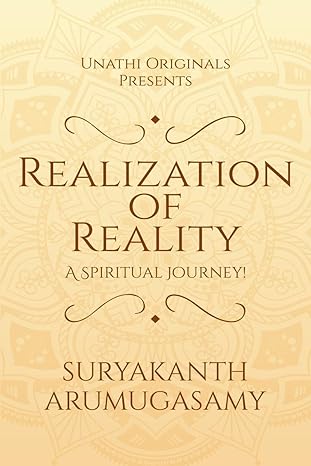
Original Title
Realization of Reality: A Spiritual Journey!
Subject & College
Series
Publish Date
2021-06-28
Published Year
2021
Publisher, Place
Total Pages
106
ISBN
9781639744671
Format
Paperback
Country
India
Language
English
Average Ratings
Readers Feedback
A Journey Beyond Reality
(Review by Nadar Nainar Kannan, First year MBA Student-Akemi Business School, Pune) Introduction • Title and Author: Realization of Reality: A Spiritual Journey by Suryakanth...Read More
Nadar Nainar Kannan
A Journey Beyond Reality
(Review by Nadar Nainar Kannan, First year MBA Student-Akemi Business School, Pune)
Introduction
• Title and Author: Realization of Reality: A Spiritual Journey by Suryakanth Arumugasamy.
• Genre and Context: This book falls under the genre of spiritual fiction and self-exploration. Published in 2021, it delves into the philosophical and existential realms of life through a captivating narrative.
• Initial Impression: Drawn by the intriguing title and the promise of a profound exploration of life’s uncertainties, I chose this book to experience its unique take on alternate realities and the choices that define our lives.
Summary
• Plot Overview: The story follows Thangaraj, a young man burdened by life’s setbacks, including the loss of his father and the failure of his business. While searching for a job, he encounters a beggar who, through a mystical spell, alters his reality. Thangaraj is thrust into a situation where he must decide between embracing an alternate reality or reconciling with his existing one.
• Themes: The book explores profound themes such as the fluidity of reality, the impact of choices, personal transformation, and spiritual awakening.
• Setting: The story is set in a modern urban environment, reflecting the struggles of ordinary life, with an overlay of mysticism that adds depth to the narrative.
• Characters/Subject: Thangaraj is the central character whose journey forms the heart of the book. The beggar serves as a catalyst for transformation, embodying wisdom and mystery.
• Writing Style: Arumugasamy’s writing is reflective and descriptive, seamlessly blending philosophical musings with a compelling narrative.
• Character Development: Thangaraj’s evolution is thoughtfully portrayed, making him a relatable and empathetic figure. The beggar, while enigmatic, adds depth to the story by challenging Thangaraj’s worldview.
• Plot Structure: The pacing is steady, with moments of tension and introspection balanced effectively. The narrative unfolds logically, keeping the reader engaged.
• Themes and Messages: The book effectively conveys its central themes, prompting readers to reflect on their own lives and choices.
• Emotional Impact: The story evokes a mix of emotions, including empathy, curiosity, and introspection, leaving a lasting impression.
Strengths & Weaknesses
• Strengths: The book’s unique premise and philosophical depth are its strongest aspects. The integration of mysticism with a relatable storyline is executed masterfully. The vivid character portrayal and engaging narrative make it a compelling read.
• Weaknesses: At times, the philosophical reflections may feel repetitive, potentially slowing down the pacing. Some readers might find the mystical elements less grounded, depending on their perspective.
Personal Reflection
• Connection: The book’s exploration of choices and alternate realities resonated deeply with me, as it reflects the dilemmas we all face in life.
• Relevance: The themes of self-discovery and resilience are universally relevant, offering insights applicable to contemporary challenges.
Conclusion
• Recommendation: I highly recommend this book to readers interested in spiritual growth, philosophical fiction, or stories that challenge conventional perceptions of reality. It’s suitable for young adults and adults who appreciate thought-provoking narratives.
